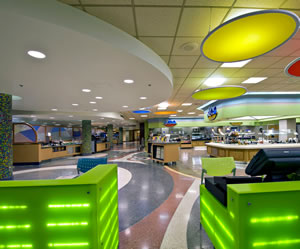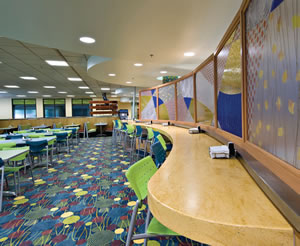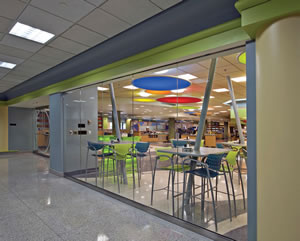Five-Second Rule

PHOTOS COURTESY OF SCHOLER CORPORATION
Food service floors work hard and look good. They handle foot traffic, rolling loads and heavy maintenance schedules. They comply with rigorous health and safety demands while looking sharp enough to impress tour groups of potential students and families. “The dining hall is the living room of the campus,” explains Michelle Maestas, project designer, Ricca Newmark Design. “We want to trigger a sense of nostalgia for home but still be vibrant, fun and energetic.” To hit that balance, designers and facility managers have an abundance of materials to choose from. How can you be sure you’re using the right material in the right place? CP&M offers a map of solutions.
If You Can’t Take the Heat
Quarry tile and poured epoxy fitted with a drain in the middle are classic back-of-house, food-prep-area choices. Popular for many decades, they offer slip resistance thanks to a natural or embedded grit. They handle greasy or acidic spills and clean up fast. They’re also a long-lived choice. “Thirty to 40 years,” estimates David Dembowitz, director of institutional markets, Patcraft. Terry Pellegrino, principal for Robert Rippe & Associates, a Minneapolis-based foodservice design consulting firm, agrees with using quarry tile and poured epoxy in kitchen areas. She advises using darkcolored epoxy or quartz grout for these surfaces, as light-colored grout will quickly look dirty and is “impossible to clean, even when sealed.” A couple small disadvantages of quarry tile, Pellegrino says, is that it is noisy, and limited color choices are available.
Other choices with different attributes are available. Poured acrylic “offers similar results to epoxy,” states Darrell Kratzer, principal, Buell Kratzer Powell. With one important difference. “It sets faster.” This makes it a great option when time is of the essence. “I just used it for a rush project. It pours right over quarry tile.”
Pellegrino adds that heat-seamed sheet vinyl is another option for kitchen areas. It is durable, seamless and soft underfoot for working, and is waterproof, slip- and wear-resistant and antimicrobial. However, it can tear on uneven surfaces, she warns, and cannot be used under cooking equipment and rack ovens. If selecting heat-seamed sheet vinyl, a qualified installer must install it.
While there is not a lot of opportunity for LEED points in the back of the house, Maestas sees some movement in that direction with a rubber/tile hybrid that looks like a sheet good but is made of recycled materials and uses a low-VOC adhesive. “I use them in dish rooms a lot,” she reports. Rubber floors are also appropriate in food-prep areas. “The only place we don’t approve of rubber floors is the fryer area,” says Melissa Quick, LEED green associate, marketing coordinator, Flexco Floors.

PHOTOS COURTESY OF SCHOLER CORPORATION
Dishing it Out
Design trends continue to blur the line between where students pick up their food and where they sit to eat it. “We’re treating the space as a whole now instead of segmenting it,” says Maestas. Part of that design solution is a monolithic floor. A monolithic floor is achieved when the floor and footing are poured together and become one single unit. Aside from it looking dynamic, a single material floor is “easier and quicker for the contractor to install,” says Caitlin Daley, senior designer, Buell Kratzer Powell.
Daily recommends a through-bodied porcelain tile for the job. Through-bodied means that the color and texture run through the tile’s entire dimensional thickness, as opposed to glazed tile, where the color and texture sit on top. “It costs a bit more but it has a great coefficient of friction, making it practically non-slip even if there is liquid on the floor.”
The tile comes in different shapes, allowing for a lot of creativity. “I recently worked with a long, linear dining space,” remembers Maestas. “I used square porcelain tiles and rectilinear planks to break up the area and create subtle patterns.” Pellegrino adds that plank porcelain tile with a wood-grain appearance is a popular choice.
Maestas is also a fan of larger format tile, 24-by-24-inch instead of 12-by-12. “It creates fewer grout lines,” she reports.
That’s important because grout is one place a tile floor can fail. Created from sand, grout absorbs stains and spills, getting darker and dirtier over time. A classic solution is to start with a darker-colored grout that will age well. Another is to use less of the material from the start. “Twenty to 30 years ago a 3/8-inch joint was common,” says Kratzer. “Today it’s down to 1/8 of an inch.” A newer product, single-component grout, offers yet another solution. Made of an epoxy instead of sand, it’s impervious to spills and needs just a Magic Eraser or Soft Scrub to bring it back to its original state.
Not everyone loves porcelain tile, however. “Ceramic tile is a natural choice, but it is extremely loud and can crack if you drop a tray on it the right way,” insists Dembowitz. Kratzer and Daley stand behind the product. “We had a client that was nervous about the tile and tried to break it with a utility knife,” remembers Kratzer. “He couldn’t even chip it.” Kratzer answers the acoustics question as well. “The only way you would have an acoustic problem with a porcelain floor is if the ceiling is low,” he explains. “Most dining halls have high ceilings to start with, and we put in an acoustical lining just to be sure.”
Luxury vinyl tile, or LVT, offers another flooring option. “It’s the fastest-growing commercial segment,” reports David Daughtrey, director of education and healthcare business development, J&J Flooring Group. “It’s more expensive up front, but it’s easy to maintain.” Available in a variety of shapes and finishes from stone to wood, LVT feels soft underfoot. Pellegrino reports that LVT installed in the front side of cooking areas is gaining popularity and holds up really well in those spaces. Different looks are available in this material.
What you’re not seeing in today’s dining halls is vinyl composition tile (VCT). “VCT looks institutional and is expensive and time-consuming to maintain,” Dembowitz explains.

PHOTOS COURTESY OF SCHOLER CORPORATION
Soft Serve
Warm and welcoming, carpet tile makes seating areas feel like home while standing up to heavy use. Maintenance means vacuuming and occasional shampooing. Tiles stained beyond regular maintenance can be lifted and replaced. New shapes, like rectangles or hexagons, open up design options. Advances in technology means that fibers and backing perform well, with antibacterial and stain resistance built in.
Hybrid products, like Kinetex from J&J, offer a crossover solution; a knitted wear layer thermally fused to a polyester felt backing. Appropriate in places you need the wear of a hard surface but want the softness of carpet, Kinetex can be lifted up, hosed off and replaced. “It dries 70 percent faster than carpet,” reports Daughtrey.
Plynyl, from Chilewich, is another crossover. “It’s like plastic carpet,” says Maestas. “It wears like tile but you vacuum and steam clean it.”
Exotic Cuisine
Designers and manufacturers continue to offer tasty new materials to clients. Sometimes clients turn up their noses. “We suggested eucalyptus in a seating area but the client didn’t go for it,” remembers Daley. “It wasn’t the cost. It was the newness of the product.”
Still, all the players understand what a well-designed, high-performance floor can do. “It’s a big opportunity,” says Maestas. “A floor can really be a project’s defining point.”
Do It Right, Keep It Clean
No matter what materials are chosen for food service flooring areas, front- or back-of-house, Pellegrino stresses the fact that “you must prepare the substrate well.” So much can go wrong with an otherwise optimal flooring choice because preparation and installation were not done correctly. In one example, epoxy-based poured flooring can crack and come up if not properly installed, she notes, and the hand-applied surface grit may not be consistent.
Another consideration: Check with the Health Department having jurisdiction as to whether the intended materials or finishes are approved for your project. And then there is the maintenance factor. Pellegrino points out that in general, food service floors are “just hard to clean, because of the grease. So we recommend a floor scrubber. Maintenance is a big part of what people think looks good.”
This article originally appeared in the issue of .